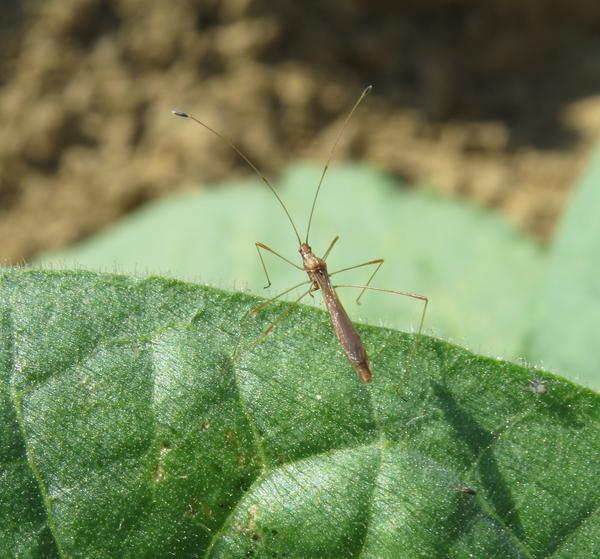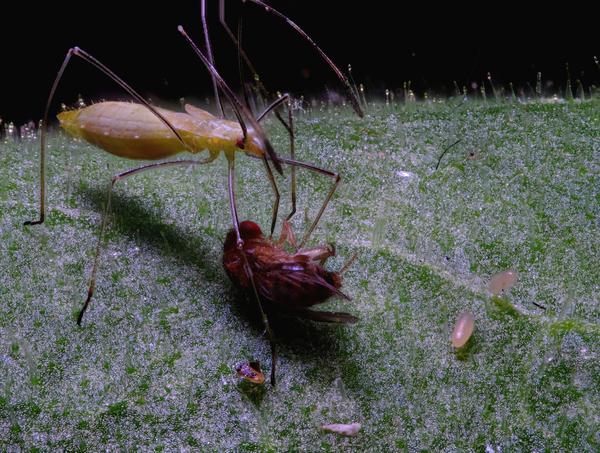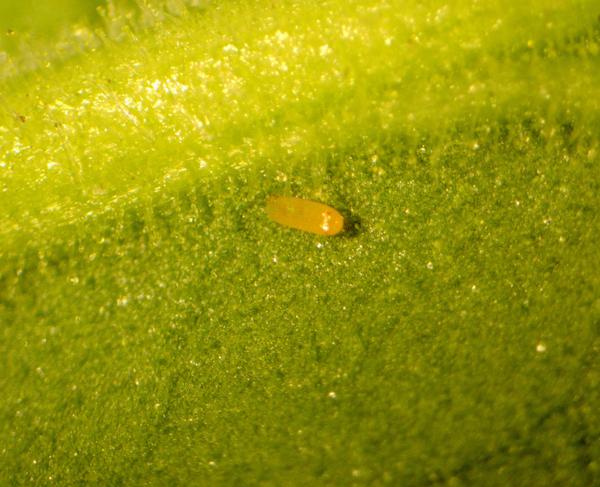Identification
Jalysus wickhami Van Duzee (Hemiptera: Berytidae), spined stilt bugs, have long, slender legs that allow them to maneuver on trichome covered surfaces that trap most insects. Using its long legs as a fulcrum, the spined stilt bug is able to remove itself from sticky surfaces, similar to a spider walking on a web. Stilt bug adults are generally brown to brick-red in color and are a ¼ inch in length with thin antennae extending roughly half the length of the body. Nymphs are yellowish green to green and shorter in length.
The spined stilt bug can be confused with another stilt bug, Jalysus spinosus (Say) (Hemiptera: Berytidae), but they can be differentiated by host. The spined stilt bug is predominantly found on “glandular-hairy” plants covered in trichomes, while Jalysus spinosus prefers grass hosts and has a distribution limited to eastern North America.
Biology
The spined stilt bug is a predaceous insect found throughout the United States, Canada, and Mexico. Spined stilt bugs are voracious predators of caterpillar eggs, including the tobacco hornworm, Manduca sexta L. (Lepidoptera: Sphingidae), and the tobacco budworm, Heliothis virescens (Fabricus) (Lepidoptera: Noctuidae), aphids, and other soft-bodied insects.
Spined stilt bugs overwinter as adults under grasses and leaves and emerge in spring to lay eggs on weeds and herbaceous plants. Eggs are white to yellow in color, oval in shape, and 1 mm in length. Upon hatching, nymphs pass through five immature stages and require both animal and plant food for development. Adult stilt bugs are first found in North Carolina tobacco from late May to early June and there are typically two generations per year with population peaks in mid July and mid August.
Significance
The spined stilt is the most abundant predator insect in tobacco and is found in other economically important crops covered with trichomes, including tomatoes. Stilt bug nymphs consume up to 12 hornworm and 80 budworm eggs per day during their development, while adults consume 2 hornworm and 10 budworm eggs per day. Over its 80 day lifespan, the spined stilt bug has the potential to prevent the development of up to 2000 budworms and 1000 hornworms, providing a massive amount of biological control.
Management
Stilt bugs feed on plant tissue, taking “drinks” of water, in the form of sap, from the plant. Because stilt bugs must feed on plants to survive, they may be exposed to insecticides applied systemically or in soil drenches. Stilt bugs are also exposed to insecticides through foliar applications. Much of the information available regarding insecticide toxicity to stilt bugs is outdated and pertains to insecticides that are no longer used. However, we do know that foliar applications of Bacillus thuringiensis, a microbial pesticide toxic to caterpillar pests, is not toxic to the spined stilt bug. Both foliar and systemic applications of imidacloprid have demonstrated relatively low levels of toxicity towards stilt bugs, and these use patterns don’t disrupt this predator’s abundance or impair their control of caterpillar pests in tobacco fields. Researchers at NCSU are currently addressing the toxicity of other contemporary foliar insecticides to stilt bugs.
Other management practices may influence spined stilt bug abundance in agricultural fields. Delayed tobacco planting dates increased populations later in the season. Non-crop plants, including alyssum, can increase stilt bug density when planted adjacent to crops such as tomatoes. Current efforts by NCSU researchers are focused on developing tactics to promote stilt bug populations in tobacco fields to enhance their biological control of key pests.
Publication date: Feb. 10, 2017
Reviewed/Revised: Dec. 10, 2021
Recommendations for the use of agricultural chemicals are included in this publication as a convenience to the reader. The use of brand names and any mention or listing of commercial products or services in this publication does not imply endorsement by NC State University or N.C. A&T State University nor discrimination against similar products or services not mentioned. Individuals who use agricultural chemicals are responsible for ensuring that the intended use complies with current regulations and conforms to the product label. Be sure to obtain current information about usage regulations and examine a current product label before applying any chemical. For assistance, contact your local N.C. Cooperative Extension county center.
N.C. Cooperative Extension prohibits discrimination and harassment regardless of age, color, disability, family and marital status, gender identity, national origin, political beliefs, race, religion, sex (including pregnancy), sexual orientation and veteran status.



